Top News

October 2, 2011 Ryukyu Shimpo
The “Choral Group for Okinawan Nursery Rhymes and School-Songs” (headed by Zenko Iramina), which consists of three nursery rhyme and school-song circles from the middle region of Okinawa Prefecture, is scheduled to participate in the 5th Worldwide Uchinanchu Festival, singing nursery rhymes to welcome Okinawans or people of Okinawan descent who now live overseas and have come to Okinawa for the festival.
The participants have practiced hard to be able to deliver tunes filled with nostalgia. They say, “Even though you may be far way from your hometowns, nursery rhymes can provide emotional support by reminding you of the country of your origin.”
About 90 people from three groups such as “Nursery Rhyme Circle Bubble” (headed by Iramina of Okinawa City), “Choral Society Izumi” (headed by Michiko Toguchi of Okinawa City) and the “Singing Voice Circle Warabe” (headed by Ryoko Agarie of Uruma City) will participate in the festival.
They are scheduled to sing nursery rhymes and school-songs such as Nanatsu no Ko, Umi, Ashimijibushi and Momiji at the Okinawa Cellular Stadium in Naha on October 14.
Iramina performed in nursery rhyme concerts in the festival to celebrate the 40th anniversary of Okinawan emigration to Bolivia held in 1994 and that to celebrate the 90th anniversary of Okinawan emigration to Brazil held in 1998.
According to Iramina, one of the people who emigrated remembered singing Umi on a ship bound for South America, and thanked her for singing it. Another man heard some of the songs for the first time in 40 or 50 years, singing along as tears filled his eyes.
Iramina is enthusiastic about welcoming Okinawans or people of Okinawan descent who now live overseas and have come to Okinawa for the festival with nursery rhymes, saying, “Nursery rhymes and school-songs remind not only first-generation Okinawan immigrants, but also those of the second and third generations, of their hometown.”
(English Translation by T&CT, Mark Ealey)
Go To Japanese
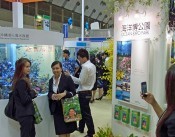
October 1, 2011 Ryukyu Shimpo
“JATA Travel Showcase 2011,” in which travel information from 144 countries and regions has been collected, opened at the Tokyo Big Sight on September 30. On the opening day, held for people working in the tourism-industry, the Okinawa Tourism Information Booth in which Okinawa Prefectural Government and the Okinawa Prefectural Convention & Visitors Bureau(OCVB) have a presence attracted the attention of many visitors. It will be open to the general public on October 1 and 2
The booth was 180 square-meters, a large area thanks to cooperation for the first time with the Ocean Exposition Commemorative Park Management Foundation, the popular boutique “Beams” and the Okinawa Prefectural Esthetic Spa Association.
The attention of visitors who enter the booth is immediately attracted by a tank of water in the middle of the space, and by the planting exhibition that also serves to promote the Asia and the Pacific Ocean Orchids Conference in 2013.
The exhibit emphasizes the tropical island image. A spokesperson for the OCVB said, “We would like to be more effective in terms of attracting women in their 30s as well as active senior citizens who have just settled down after completing their years devoted to bringing up children. We hope that this will help us overcome the sluggish demand that has followed the Great East Japan Earthquake.” Okinawan products are on display and there is food-sampling run by the Washita Shop and recommended by Beams. The Okinawa Prefectural Esthetic Spa Association also demonstrated in the space, introducing the facilities of the members in the prefecture and distributing pamphlets to visitors. Mariko Yoza, a member of the association, said, “We would like to introduce Okinawan Spas, which are known for being safe and secure, to a broad range of people.”
(English Translation by T&CT, Mark Ealey)
Go To Japanese
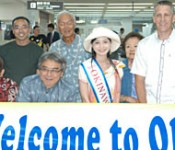
September 30, 2011 Ryukyu Shimpo
The first flight operated by United Airlines from Guam Airport arrived at Naha Airport at 9:00pm on September 28.
At the Naha International Air Terminal building, the Okinawa Prefecture and the Okinawa Convention and Visitors Bureau held a welcoming ceremony fronted by Okinawa Vice Governor Yoshiyuki Uehara for about 50 passengers on the occasion of the recommencement of regular flights between Naha Airport and Guam Airport. Regular flights between these two locations recommence after a gap of 12 years and this is now the sixth regular flight between Okinawa and foreign destinations.
The airline Continental Micronesia used to provide regular flights between Naha and Guam, but it stopped the service from 1999 due to a decrease in demand. The company was subsequently merged into United Air Lines which decided to resume the service, because it expects there to be an increase in demand for flights from Okinawa and because it forecasts that it is entering a period of stable management.
United Airlines now operates four flights a week between Naha and Guam.
Second-generation Japanese-American 80 year-old Sally Matsumoto, who now resides in Hawaii, said, “I flew here to Okinawa to see my relatives and I think many other people will use these flights to Okinawa from now on.”
(English Translation by T&CT, Mark Ealey)
Go To Japanese
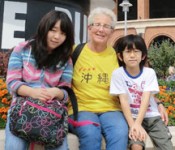
September 30, 2011 Ryukyu Shimpo
Miyu Kaname, a 13 year-old girl from Urasoe City, will return home on November 7. She has recovered well from heart transplant surgery carried out this April at Columbia University Hospital in New York to correct her restrictive cardiomyopathy. After she returns to Japan, Miyu will be hospitalized in Osaka University Hospital for about a week to undergo a range of checks before returning to Okinawa on November 14.
Miyu has routine cardiac catheterization and physiology tests every month, and no rejection in terms of heart function has been detected, so she is recovering smoothly.
Her father Toshiaki said, “Miyu is delighted to be able to come back to Okinawa. She wants to meet her friends, and to see the room-mates with whom she was hospitalized in Okinawa.”
A representative of the Miyu-Aid Office reports on the Miyu-chan Aid blog that “Miyu was able to travel to the United States thanks to assistance and warm encouragement from many kind-hearted people. She has been able to undergo a successful heart-transplant, without any infection or post-operative problems and the date of her return home has now been decided. We thank so many people for their kind assistance.”
(English Translation by T&CT, Mark Ealey)
Go To Japanese

September 29, 2011 Ryukyu Shimpo
The “king” and “queen” selected in a contest at the 18th Shurijo Castle Park Mid-Autumn Celebration on September 11 visited the Naha City Office to receive certificates from Naha City Mayor Takeshi Onaga, who also serves as chairman of the Shuri Castle Festival Executive Committee.
Twenty-seven year-old nursery school teacher and resident of Yaese Town Kentaro Miyagi, who was selected as “king” said, “I will do my best to let people of the next generation know about the charm of Okinawa, including its unique culture.”
Second-year student of the University of the Ryukyus 20 year-old resident of Ginowan City, Aya Miyazato, who was selected in the role of “queen,” said, “Ever since I was a child, I have always wanted to become ‘queen.’ I want to use this experience to help promote the future of tourism in Okinawa.”
They are scheduled to participate in the Ryukyu King’s Coronation Ceremony in the Una Forecourt of Shurijo Castle Park on October 29, and the Ryukyu Kingdom Royal Procession, scheduled to be held in Kokusai-Dori (International Street), on October 30.
(English Translation by T&CT, Mark Ealey)
Go To Japanese
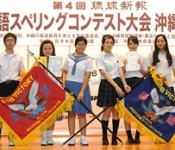
September 27, 2011 Ryukyu Shimpo
The final of the 4th English Spelling-Bee Contest, sponsored by the Ryukyu Shimpo, the Executive Committee Considering Teaching English in Okinawa and the NPO Cross Cultural Collective, and co-hosted by the U.S. Consulate General Okinawa, was held at the Ryukyu Shimpo Hall in Izumisaki, Naha City, on September 25. The Brilliant3 team (Shuri Junior High School) and the Krishna team (Showa Pharmaceutical University Affiliated High School) came first in their respective sections.
The Shuri Junior High School team members were Rina Araki (first-grade), Keigo Shimabukuro (second-grade) and Moko Matsumoto (third-grade). They seemed a little tense because the team was making its first appearance in the contest, but they managed to answer the questions confidently in a loud voice. The three members were thrilled with the result, saying, “We are really happy to achieve this after having practiced so much after school.”
The Showa Pharmaceutical University Affiliated High School team was made up of Seira Bakushi (first-grade), Keito Ishimine (first-grade), and Sonoko Nagata (second-grade). They commented that they could not practice as much as they would have liked because the contest was held the day before their school festival, but they still managed to display their ability. Smiling, the three said, “We approached the contest with a fierce determination to win and it went really well.”
(English Translation by T&CT, Mark Ealey)
Go To Japanese

September 27, 2011 Ryukyu Shimpo
On September 26, the Awamori Meister Association (Chairman Katsunobu Arakaki) and the Taiwan Beverage Association (Chairwoman LI Yue-Qin) signed a sister organization agreement at the Okinawa Prefectural Office. As they seek to strengthen cooperation through economic and cultural exchanges, both associations are promoting Awamori in Taiwan.
The Taiwan Beverage Association is an incorporated body with about 350 members, including retailers and restaurants and individuals. In November 2010 the Taiwanese government approved the establishment of the association, which focuses on employment support projects for human-resource development in the food industry. Both organizations seek to improve the skills and service ability of their members through personnel exchanges.
The Awamori Meister Association signed a sister organization agreement with the Taipei Bartenders Association on October 10, last year. The members of Awamori Meister Association then attended the inaugural meeting of the Taiwan Beverage Association in March, 2010, and to promote awamori they have expanded their exchanges with colleagues in Taiwan.
The Association is planning to organize a course of lectures on awamori in Taiwan and hopes to produce a Taiwanese Awamori Meister who gets his or her qualification in Taiwan. Chairman Arakaki said, “We would like to contribute to promote awamori in Taiwan. We hope to also promote cultural exchanges between Okinawa and Taiwan, and to promote tourism.”
(English Translation by T&CT, Mark Ealey)
Go To Japanese
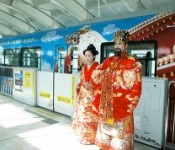
September 27, 2011 Ryukyu Shimpo
On September 26, a ceremony to mark the departure of a monorail carriage named “the Yui Rail Shuri Castle,” which has been wrapped with a picture of the castle, was held at Naha Station on the Okinawa City Monorail Line (Yui Rail) in conjunction with the upcoming 5th Worldwide Uchinanchu Festival.
The “king” and “queen” of the Shuri Castle Festival welcomed people onto the monorail as though the passengers were envoys from China back in the days of the Ryukyu Dynasty.
This carriage is scheduled to run seven or eight times a day between Naha Airport and Shuri until the end of March 2012.
At the ceremony, the president of Okinawa Urban Monorail Co. Inc., Ryoji Nakayoshi, delivered a speech in which he said, “I think that the Shuri Castle carriage will be very popular. People will say that it will be lucky if you see it, and that happiness will come your way if you ride in it.”
Takayuki Ikeda, head of the Ocean Exposition Commemorative Park Management Foundation called upon many people to come and ride the monorail, saying, “The ‘Shuri Castle’ reminds residents of Okinawa and tourists about the glory of the Ryukyu Dynasty and passes on a message of support for Uchinanchu all over the world.”
(English Translation by T&CT, Mark Ealey)
Go To Japanese
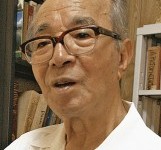
September 25, 2011 Tsuyoshi Arakaki of Ryukyu Shimpo
In 1980, Sachio Inoue, then a senior advisor of “Nuclear Fuel Services” (now Nuclear Fuel, Rokkasho-mura, Aomori Prefecture), visited Okinawa to look into the building of a facility “on the island of Yaeyama” for the final disposal of radioactive waste. He met with a chief councilor of the Okinawa Prefectural Government (OPG) and talked about “a base for plutonium waste.” The chief councilor speculated that the company was seeking a place to dispose of high-level radioactive waste that needs to be buried deep underground. Nuclear Fuel Services was a state-run company established to operate in the commercial nuclear fuel cycle. Inoue had previously worked as an administrative vice‐minister for Okinawa Development Agency.
In the winter of 1980, Inoue visited Naha City to meet with the chief councilor of the OPG, Seizo Oshiro (now 81 year-old), who had been the director of the Tokyo Office of the OPG for five years from 1973. Inoue invited Oshiro to dinner, and in the course of their conversation, said, “I went to the island of Yaeyama to see if there might be a place there for the final disposal of plutonium, but things weren’t very favorable.” Inoue did not give the specific name of an island. Oshiro said, “Mr. Inoue did not seem very enthusiastic about the task he had been given.” Recalling that day, Oshiro said, “I thought that people in the main islands of Japan were intent on bringing more bad things into Okinawa, on top of the U.S. military bases that no area of Japan was keen to host.” Inoue had served as a budget officer in the Ministry of Finance where, according to Oshiro, “He made significant contributions” in terms of acquiring budget for Okinawa. Inoue was the Director of the Development and Promotion Bureau of Okinawa Development Agency in 1974 and served as the permanent secretary for that agency for two years from 1977.
According to Japan Nuclear Fuel, Inoue became a senior advisor for them in July 1980, working in that role until he passed away in March the following year.
The company did not confirm that they proposed Okinawa as a location for disposal of nuclear waste, going no further than saying, “We have no information on that.”
High-level radioactive waste is now stored as vitrified waste in the long-term storage facility in Rokkasho Nuclear Fuel, with other radioactive waste being placed in the storage pool of nuclear power plant sites, but the location for final disposal is still undecided.
Countermeasures, including technical means for the final disposition of radioactive waste have still not been established because radiation may possibly leak into groundwater even if the waste is sealed with multiple barriers and buried at a deep geological layer. Some experts consider these measures to be insufficient for coping with earthquakes and volcanic activity, and such high-level radioactive waste also attracts attention on an international level because of the possibility of extracting large amounts of plutonium, which can be diverted for use in nuclear weapons.
Hitoshi Yoshioka, vice president of Kyushu University and an expert on science policy, said that seeking a place to use as a radioactive waste repository in Yaeyama “matches the time from the late 1970s when they began looking for land to use as a final disposal site,” and continued by saying, “It cannot be denied that an island in Okinawa may emerge as a possible candidate as a site for final disposal.”
(English Translation by T&CT, Mark Ealey)
Go To Japanese
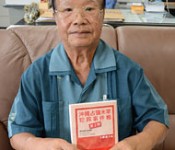
September 26, 2011 Ryukyu Shimpo
A book entitled “The Record of Crimes Against the Okinawan People by U.S. Military Occupation Forces – Volume 2” was published recently by 72 year-old Morio Tengan, a resident of Uruma City and former director of the Koza Labor Management Office of the Okinawa Prefectural Government (OPG). Tengan explained his reason for publishing this book saying, “I want the next generation of people to understand the hardships that Okinawa’s grandmothers and grandfathers have endured since Japan’s defeat in the war.” In the book, Tengan covers crimes by committed by U.S. military against local people during the 20-year period of military administration from the ratification of the San Francisco treaty in April 1952, when Okinawa was separated from Japan, until the Okinawa reversion to Japan in 1972.
Tengan was employed by the Legal Affairs Division of the Ryukyu Government after graduating from Hosei University. He subsequently moved steadily through the ranks, before going on to serve as the secretary-general of the Okinawa Prefectural Foundation for Claims Regarding U.S. Acquired Assets. He has worked as a specialist on the handling of claims by victims of a large number of crimes by the U.S. military and its personnel.
In his first book, published in 1999, he wrote about U.S. military crimes during the period between the date of the end of the war, August 15, 1945, and April 27, 1952. In this second book, using materials from the time, he has faithfully recorded the cases of murder, rape, hit-and-run, and other crimes by U.S. military personnel. Readers soon come to understand what he terms: “The period when Okinawan people had no human rights.”
In the first part of this book Tengan describes Okinawa as a junkyard of U.S. bases, suggesting that despite 66 years having passed since the end of World War II, “Okinawa is located amongst U.S. bases” because both the Japanese and United States governments have forced huge military bases on Okinawa, which represents less than one percent of the total land area of Japan.
In the second half of the book, called “The criminal record of the U.S. Military Occupation Forces,” he classified cases under the headings of “rape,” “crimes with guns,” “assault causing injury,” “robbery, theft, assault, and destruction of property” and others.
Tengan said, “In my two books I have recorded many of the crimes committed by U.S. soldiers, but this is just the tip of the iceberg – the number of crimes committed by the U.S. military and its personnel has not decreased since the reversion of Okinawa to Japan, and the people of Okinawa prefecture are still oppressed.”
The book sells for 1500 yen. Please direct inquiries to phone number 098 (973) 4356.
(English Translation by T&CT, Mark Ealey)
Go To Japanese

September 23, 2011 Yoko Ikeda and Junko Uechi, correspondents of Ryukyu Shimpo
In the morning of September 22, the ferry Daito arrived at Kita and Minami Daito for the first time in 18 days, after several sailings had been cancelled because Typhoon No. 15 had lingered in the Okinawa area since September 4. After it arrived, containers were unloaded onto the wharf one after another. On both islands, having run out of grocery supplies, many relieved residents who had been waiting for the arrival of the ferry rushed to stores to purchase fresh food.
Ten people lined up in front of the Yogi Grocery Store in Minami-Daito Village even before it opened its doors. Normally a total of about 100 people come to shop at the store each day, but on this particular day about 50 customers came in just one hour. Noriko Yamashita, the manager of the Minami-Daito Jima store of A Corp JA Okinawa smiled as she said, “The harvest festival is going to be held on September 22 and 23, so it is really good that foodstuffs have arrived in time.”
At the Miyagi Store on Kita Daito Village, dairy products, bread and vegetables sold at a rapid pace. Ayano Miyagi, a 33 year-old woman who has lived on the island for about two years since marrying a local man said, “This is my first time experience of this kind of food shortage, and I’m certainly relieved that it’s over!”
(English Translation by T&CT, Mark Ealey)
Go To Japanese











 Webcam(Kokusai Street)
Webcam(Kokusai Street)


